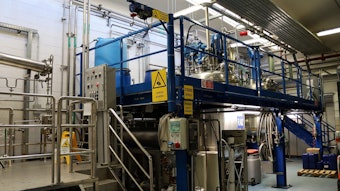In order to substantiate claims, manufacturers and brands must prove that their products do what they claim with the safety of the consumer in mind. The Cosmetic, Toiletry, and Fragrance Association (CTFA) recently introduced its new commitment code for cosmetic companies, promoting industry self-regulation regarding product safety. As a self-regulated industry, scientific data that validates cosmetic and personal care products builds trust between the brand and the consumer. With increasingly advanced products, such as those for antiaging skin care, measuring products’ effects is becoming even more vital to boosting consumer confidence.
“Efficacy testing and validation of skin care products need increasingly rigorous scientific methodology if they are going to stand up to regulator and consumer demands,” said Annie Brooking, CEO of Astron Clinica. “It’s about quantitative data as well as qualitative results.” Observing basic changes to the surface of skin is not enough. Using techniques that map the skin, practitioners can view the skin’s relative age, thus creating specialized treatment plans to manage aging skin. For marketers, this measurement creates conclusive scientific proof that their products should be part of this skin management regimen.
Chromophore Mapping
In a study conducted by Paul J. Matts, PhD, associated with P&G Beauty; and Symon D. Cotton, PhD, associated with Astron Clinica, Ltd. in the U.K., the visual inspection of the chromophore maps of young and aged subjects revealed a contrast, particularly for the melanin and hemoglobin chromophores. (See What is a chromophore?)
In young skin, these chromophores are distributed in an extremely homogeneous manner—consistent with the delicate, even palette of youth. With age, a significant increase in both total concentration and in homogeneity is evident for both chromophores, producing wrinkles, lines and dark spots. An apparent “lag” phase for total skin concentrations of both chromophores (lasting until approximately age 30 for melanin and 40 for hemoglobin) occurs as skin ages, after which there was a steady increase in each chromophore total concentration with a concurrent progressive increase in inhomogeneity of each pigment.1 Collagen maps reveal an apparent overall loss in both density and the skin’s fine “egg-box” lattice with age. These concentrations over time showcase the skin’s true age below the surface.
“It creates a beauty timeline that can be used to manage skin health,” said Suzanne MacDonald-Carr, Astron Clinica. This data appears to confirm chromophore mapping as a tool to characterize and explain the visual appearance of aging skin. “Procter & Gamble was the first to identify the fact that the three chromophores of hemoglobin, melanin and collagen determine the way skin looks,” said Brooking. Chromophore mapping measures them without taking a biopsy, which is important within the cosmetics and personal care industry.
Below the Skin
Cosmetrics is a data system that visualizes and measures living hemoglobin, melanin and collagen up to 2 mm under the surface of the skin in vivo. It is powered by Astron Clinica’s SIAScopy IV, a skin visualization and measurement tool used by the medical profession to detect skin cancer. The system provides an accurate portrait of the skin’s structure by channeling these views and measurements into programs that can be used for clinical trials, product testing and validation processes, thus shrinking the work and costs involved in proving the effects of skin care products on hemoglobin, melanin and collagen. When the scanner illuminates the skin, some of the light is reflected and scattered from the surface. The remainder is transmitted into the top layers of the skin. Varying fractions of the incoming light then are absorbed by the melanin in the epidermis before entering the dermis, where they are absorbed by the hemoglobin in the blood vessels. Scattering also occurs in the dermis when the light interacts with the collagen, resulting in a portion of the light being re-emitted back to the surface. Scans are produced by interpreting the combination of wavelengths. Users are then presented with generated scans and statistics for interpretation.
“(The software) is also managing the data, so it does the statistical analysis for you,” said Brooking. “The computer looks at all the scans, and can provide evidence for product claims, particularly with proliferation or skin whitening and age spots. It is possible to measure color and size of age spots.”
Sun damage, caused by skin deterioration due to UV exposure, manifests itself in both hemoglobin and melanin. By evaluating these two chromophores, this damage can be measured over time, while creating a baseline for comparison of product effectiveness. This software also determines whether melanin is in the top layer of the skin or whether it has moved deeper into the tissue, which can determine skin treatments effectiveness.
The Mexamèter MX 18 from Courage and Khazaka Electronic GmbH, also measures the melanin content and hemoglobin level through a probe that emits three specific light wavelengths. The receiver measures the light reflected by the skin, and the melanin is measured by specific wavelengths chosen to correspond to different absorption rates by the pigments. For the hemoglobin measurement, specific wavelengths are used, corresponding to the spectral absorption peak of hemoglobin and to avoid other color influences. The results for both parameters are immediately shown as index numbers. This device measures differences in the skin in vivo, allowing for the mapping of melanin and hemoglobin levels over time. These devices document changes in the sizes of spots and in heterogeneity of pigmentation, subsequent to and after application of skin care products.2 Both devices show a correlation on the spotted skin, as well as a reduction over time in the color of the treated spots and a reduction in color of unspotted treated skin.
Both of these testing applications allow measurement of skin pigmentation and collagen, thus giving labs a scientific testing method to verify the effectiveness of cosmetic and personal care products. The color of the skin and overall evenness can be measured, thus showing an increase or decrease in the signs of skin aging below the surface. Additionally, these tools can monitor the progress of treatments for acne, skin cancer and other skin conditions. Products then can be fine-tuned earlier in the development stage through measuring small changes unseen to the naked eye. At the same time, these measuring devices allow scientists to validate product claims using a repeatable testing standard.
References:
- PJ Matts et al., Chromophore Mapping: A new technique to characterize and measure aging human skin, in vivo. J of the Am Acad Derm, 52(3) Supplement (2005)
- J Asserin et al., Comparison of two techniques used in the evaluation of the depigmentation effect of cosmetic products on brown spots. Astron Clinica—Clinical papers (2004)










